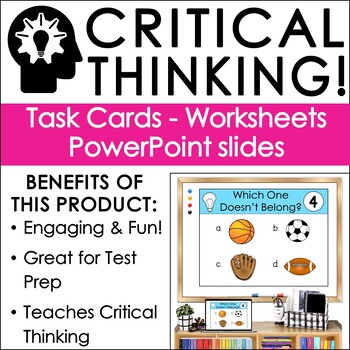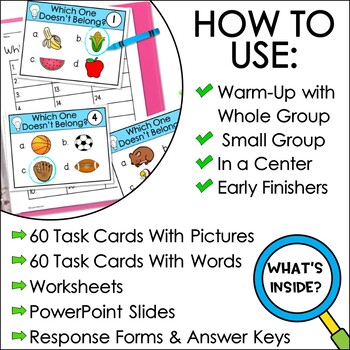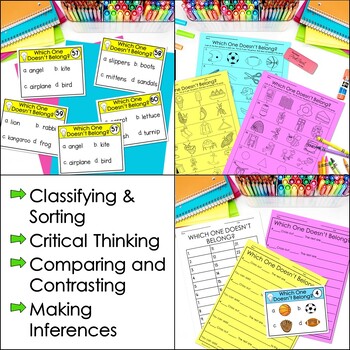Common Nouns Which One Doesn't Belong? Classifying Vocabulary Activities
- Zip
What educators are saying
Also included in
- Teach grammar, vocabulary and thinking skills with these fun Sorting and Classifying Common Nouns & Vocabulary Activities with Noun Cards Bundle. These activities are the perfect way to teach standard vocabulary acquisition and use. The resource includes common nouns vocabulary activities and nPrice $5.25Original Price $7.50Save $2.25
Description
These Which One Doesn't Belong? Common Noun Task Cards and worksheets are a fun way to incorporate critical thinking while teaching Vocabulary Acquisition and Use and Negation in Speech Therapy.
Your kiddos will have great conversations as there can be more than one correct answer. This activity is great for early finishers, gifted, and ELL students! Be sure to check out the PREVIEW to see more detail.
MATERIALS IN THIS PRODUCT INCLUDE
•Which word does not belong? – 60 task cards with pictures and 60 task cards with words, - also available as individual PowerPoint slides
•10 worksheets in which there are four pictures on each row and students identify which picture or word does not belong.
•Recording Sheets and Answer Keys
THESE CARDS MAY BE USED:
- with a whole class as a morning warm-up
- in small groups
- individually
- in a center
WHY DO I NEED THIS?
We need to provide even our youngest students with activities that require critical thinking. As students create categories using words and pictures, they develop analysis, discrimination, comparison, and logical thinking skills. Identifying similarities and differences helps students see patterns and make connections.
Students develop logical reasoning skills when they analyze a group of items and observe their characteristics. They must be able to see patterns and make connections as they sort, group, and classify through comparing things that are similar and contrasting things that display differences.
WHAT OTHERS ARE SAYING:
I was hoping to find a resource that would look exciting enough to keep my students engaged, and this truly has meant my expectation and more! My students adore the pictures. I also love how this one resource targets categorization on so many different levels, thanks for creating this!
*****************************************************************************
CUSTOMER TIPS:
How to get TPT credit to use on future purchases:
• Please go to your My Purchases page (you may need to login). Beside each purchase you'll see a Provide Feedback button. Simply click it and you will be taken to a page where you can give a quick rating and leave a short comment for the product. Each time you give feedback, TPT gives you feedback credits that you use to lower the cost of your future purchases. I value your feedback greatly as it helps me determine which products are most valuable for your classroom so I can create more for you. ☺
Be the first to know about my new discounts, freebies and product launches:
• Look for the green star next to my store logo and click it to become a follower. Voila! You will now receive email updates about this store. ☺
*****************************************************************************
Keep 'em Thinking!
Susan Morrow
Connect with Me






